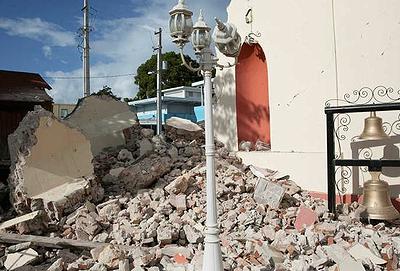
SAN JUAN, Puerto Rico, January 10, 2020 (ENS) – A 6.4-magnitude earthquake struck Puerto Rico early Tuesday, killing at least one person and leaving several others injured in the southern part of the Caribbean island, according to official reports.
Over the past several weeks, hundreds of small earthquakes have occurred in this same region. At least 300 homes were destroyed in the M 6.4 quake and 6.0 aftershock, the strongest to hit the island in 102 years. The only confirmed death is a 73-year-old man in the southern city of Ponce.

On Friday, two-thirds of Puerto Rico is still without power, and a quarter of the island is without running water. The earthquakes destroyed Puerto Rico’s main generating facility, the Costa Sur plant, which, until Tuesday, supplied about a quarter of the island’s power.
Officials have said that power will not be restored to the island’s three million people until this weekend, and it will take a year to fix the Costa Sur plant.
Puerto Rico’s Governor Wanda Vázquez declared a state of emergency after the series of earthquakes struck the U.S. commonwealth. Vázquez, who also activated the National Guard, said at a news conference Tuesday that the earthquakes sparked power outages and cut off drinking water to 300,000 people across the island.
Early Wednesday, President Donald Trump signed a federal disaster declaration request.
Nearly 200 Puerto Rico National Guard members are assisting in the recovery efforts, many helping military police secure shelters, where some 2,000 people are staying. Maj. Gen. José J. Reyes, adjutant general of the Puerto Rico National Guard, said his engineers will be inspecting bridges for damage and deploying emergency teams and tactical vehicles.
Puerto Rico is still recovering from the disastrous effects of Hurricane Maria, a deadly Category 5 hurricane that devastated Dominica, St Croix, and Puerto Rico in September 2017. It killed at least 3,057 people and ripped out power lines and water supplies across the island.

The location of Tuesday’s 6.4 magnitude quake is within 12 kilometers (7.4 miles) of a M 5.8 earthquake on January 6. Over the past several weeks, hundreds of small earthquakes have occurred in this same region, beginning with a M 4.7 earthquake late on December 28 and a M 5.0 event a few hours later.
Since the M 4.7 event, over 400 M 2+ earthquakes have occurred in this region, 11 of which were M 4+, including Tuesday’s M 6.4 event and the January 6th M 5.8. The proximity of these events to the island of Puerto Rico, and their shallow depth, mean that dozens of these events were felt on land.
A famous tourist landmark and one of Puerto Rico’s most beloved natural wonders collapsed Monday after the M 5.8 quake shook the island, Guaynilla Mayor Nelson Torres Yordan told reporters.
Punta Ventana, which translates as Window Point, was a stone arch shaped like a round window located in Guayanilla along the island’s southern coast. Monday’s M 5.8 earthquake destroyed the natural formation.
The UPRM Meteorological Laboratory shared a photo on Twitter of Punta Ventana before and after the earthquake, showing where the soaring arch once stood before its tragic collapse.
A colonial church constructed in 1841 also “totally collapsed,” during the earthquake, according to Yordan.
The strongest quake, the M 6.4 event which struck nine miles from Guayanilla, Puerto Rico on January 7 at 12:24 am, also shook other Caribbean islands: the Bahamas, the British Virgin Islands, Dominica, Dominican Republic, Saint Martin, Sint Maarten, Guadeloupe, Haiti, Montserrat, Saint Kitts and Nevis, the Turks and Caicos Islands, the U.S. Virgin Islands, the Caribbean Netherlands, Saint Barthélemy, Antigua and Barbuda, and Anguilla.
Copyright Environment News Service (ENS) 2020. All rights reserved.
© 2020, Environment News Service. All rights reserved. Content may be quoted only with proper attribution and a direct link to the original article. Full reproduction is prohibited.
